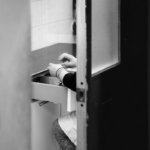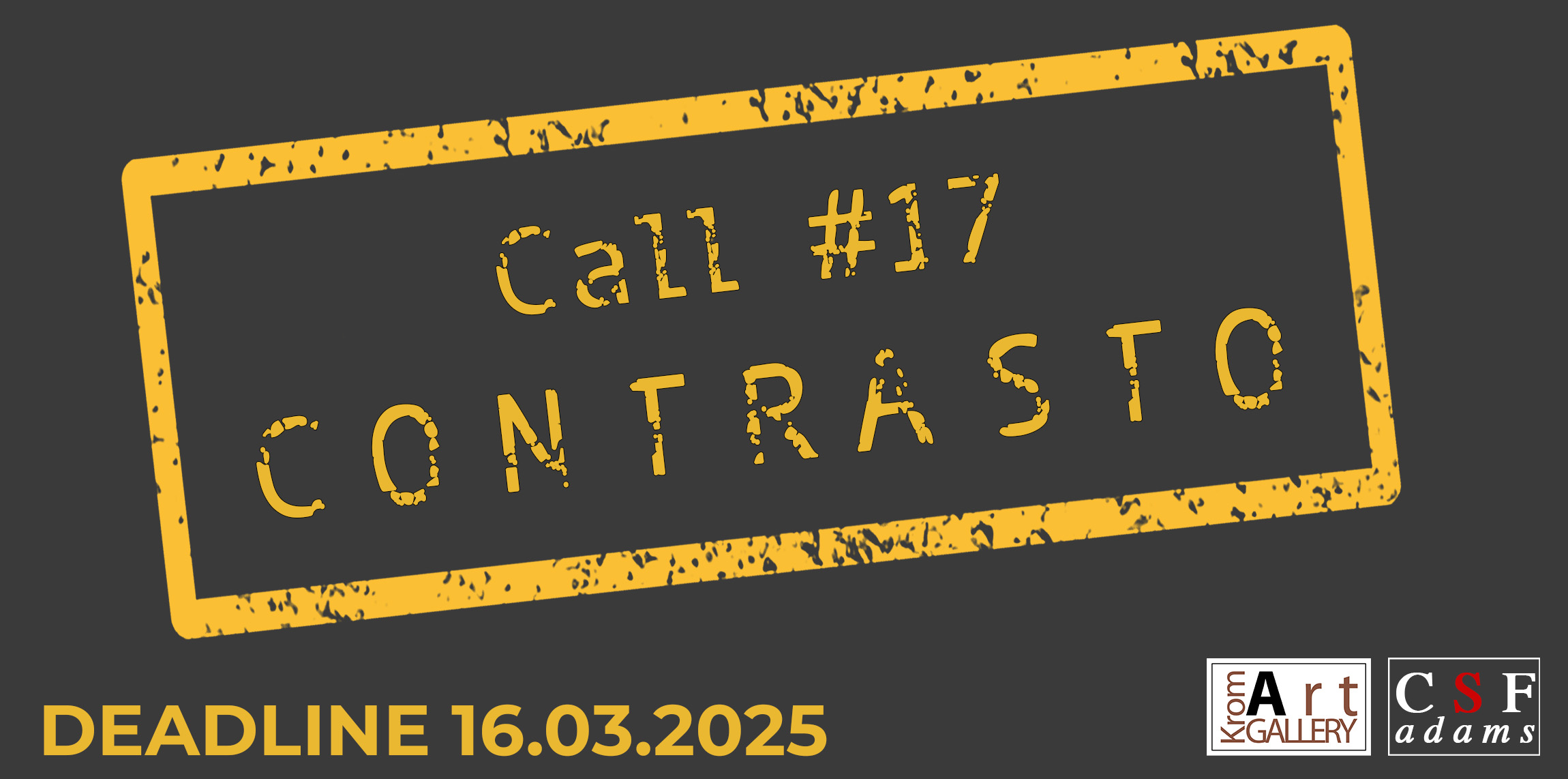
Call #04 | Sulla strada
Andrea Bellettini
ujat65@gmail.com | instagram: @ujat28mm
Vivo e lavoro a Ravenna.
Non sono un fotografo professionista, neanche mi sento artista; ma la fotografia mi accompagna, quasi mi assilla, dall’età di 16 anni. In quel momento, compreso il mio interesse, i miei genitori mi regalarono la mia prima reflex.
Cerco nella fotografia uno sfogo ad un bisogno di espressione con cui mi ritrovo da sempre a fare i conti. Non sono mai stato costante nella mia carriera di fotoamatore, tant’è che, ad esempio, non sono mai riuscito a mettere insieme una camera oscura, ed ho solo un portfolio… per il momento. C’è stato inoltre un lungo periodo in cui non ho quasi più praticato. Ma tutto è sempre rimasto nei miei pensieri. Ora ho ripreso a scattare con maggiore determinazione, e probabilmente più
consapevolezza. Grazie ad un corso di fotografia, non un solito corso, ho conosciuto la Street Photography e le opere dei suoi maestri.
Ho capito che, per quanto possa essere difficile, questo è il genere in cui mi voglio cimentare.
Una volta cercavo l’evento, il luogo particolare o il viaggio come pretesto per fotografare. Ma in realtà ho compreso che “l’evento” può essere ovunque ed accadere in
qualsiasi momento, l’ispirazione è dietro l’angolo, basta osservare con accettazione e pazienza. Molta pazienza. E nella fotografia di strada il flusso degli eventi e dei potenziali soggetti è infinito!
Cosi deve essere infinita la costanza e la pratica dell’affinare lo sguardo; a casa, al lavoro, per strada, di giorno e di notte, la mia fotocamera ora è sempre con me!
Sono attratto dai colori, ma alla fine molte immagini le vedo in un bianco e nero molto contrastato, esaltato dall’uso del flash; credo che molte mie foto siano sogni ad occhi aperti o situazioni cariche di un sentimento di nostalgia che in qualche modo si materializza di fronte a me e che io devo fermare.
Sono inoltre membro di Romagna Street Photography, collettivo di fotografi basato in Romagna con l’interesse comune di documentare la vita delle nostre province per mezzo del linguaggio della Street Photography.
I live and work in Ravenna.
I’m not a professional photographer, I do not even feel an artist; but photography accompanies me, almost assails me, from the age of 16. At that moment, my parents gave me my first SLR.
In photography I look for an outlet for a need for expression with which I have always come to terms. I have never been constant in my career as an amateur photographer, so much so that, for example, I have never been able to put together a darkroom, and I have only one portfolio… for now! There was also a long time when I hardly practiced anymore.
But everything concerning photography has always remained in my thoughts. Now I resumed shooting with greater determination, and probably more awareness.
Thanks to a photography course, an unusual course, i’ve met Street Photography and the works of its masters.
I understood that, as difficult as it may be, this is the genre in which I want to challenge myself.
Once I was looking for the event, the particular place or the trip as a pretext to photograph. But in reality now I realized that “the event” can be anywhere and can happen at any time, inspiration is around the corner, just observe with acceptance and patience. A lot of patience. And in street photography the flow of events and potential subjects is infinite!
Thus the constancy and practice of sharpening the gaze must be infinite; at home, at work, on the street, day and night, my camera is always with me!
I am attracted by the colors, but in the end I see many images in a very contrasted black and white, enhanced by the use of flash; I believe that many of my photos are daydreams or situations full of a feeling of nostalgia that in some way materializes in front of me and that I must freeze.
I am also a member of Romagna Street Photography, a collective of photographers based in Romagna with the common interest of documenting the life of our provinces through the language of Street Photography.
Ultima notte in Riviera
Per una volta tutto inizia al tramonto. Come se fossi invisibile, scivolo in mezzo alla folla di ragazze e ragazzi che minuto dopo minuto
aumenta sempre di più. Sono tutti sovreccitati, sopra le righe, molti già quasi ubriachi.
Di tanto in tanto incontro qualcuno “maturo” quanto me e mi sembra ancora più eccentrico ed eccitato dei più giovani.
Da muri di casse alti come palazzi, i decibel della techno si avventano sui corpi seminudi e danzanti ed in estasi, come alla soglia di un tempio durante un antico rito.
Per una volta tutto questo avviene all’aperto, sotto il cielo, nello spazio di tre kilometri di molo, e nonostante questo l’atmosfera è rovente.
La musica mi è quasi insopportabile, e allora accendo il flash, abbasso il volume… quello che mi è rimasto di quella sera lo vedi qui…
One last night on the Riviera.
For once, everything starts at sunset. As if I were invisible, I slip into the crowd of girls and boys that grows more and more minute by minute.
They are all overexcited, over the top, many already almost drunk. From time to time I meet someone “mature” as I am and it seems even more eccentric and
excited than the younger ones. From walls of loudspeakers tall like buildings, decibels of techno-music pounce on halfnaked and dancing bodies, in ecstasy as on the threshold of a temple during an ancient rite.
For once, all this happens outdoors, under the sky, in the space of three kilometers of pier, and despite this the atmosphere is searing hot.
The music is almost unbearable, and then I turn on the flash, turn down the volume … what I have left of that evening you see it here …
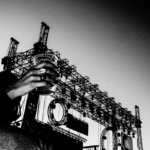
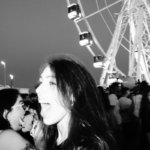
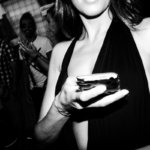
Elisa Clementelli
Nata a Roma il 3 Marzo del 1994, dopo il liceo intraprende gli studi di montaggio video presso la Civica Scuola di Cinema Luchino Visconti a Milano. Ha concluso gli studi con una tesi sull’eticità dell’immagine nel sociale e con un corto di fiction “Daughterland”, selezionato in quattro festival internazionali; rientrata a Roma per iniziare uno stage sul film prodotto dalla Lotus. La passione per la fotografia si concretizza con gli Studi presso il CSF-Adams, dove frequenta il corso avanzato.
Il suo impegno nel sociale rimane sia a Milano che a Roma. In quest’ultima città, segue un progetto dell’Unione Europea sulla prevenzione della dispersione scolastica dei ragazzi Rom, con la finalità di far realizzare ai ragazzi stessi una mostra fotografica sulla discriminazione.
Was born in Rome on the 3rd of March, 1994. After high school, she undertakes the video editing’s studies in the Civica Scuola di Cinema “Luchino Visconti”, in
Milan. She graduates with a thesis about ethics of socially-committed image and with a short film, named “Daughterland”, selected in four international festivals. She’s now in Rome to begin a stage in Lotus production’s new movie.
Her passion for photography takes the form with her studies at the CSF-Adams, where she attends the advanced course.
Her commitment in social continues both in Milan and Rome. In this latter city, she follows an European project about Rom kids’ school dropout’s prevention, with the purpose of making the same guys realize a photography exhibition about discrimination.
Sbirciando ad est
Dal 2016 ha avuto l’occasione di “sbirciare” ad Est, ovvero in Romania: prima con la sua passione per il volontariato, poi per un viaggio di piacere a Bucarest.
Proprio in questa occasione cerca di catturare con la fotografia le persone che incontra e che le trasmettono un po’ della loro storia, in una città che si sta lasciando alle spalle il proprio passato di dittatura e povertà.
Since 2016 she has had the opportunity to “peek” in the East, that it is in Romania: first with his passion for volunteering, then for a pleasure trip to Bucharest.
On this occasion she tries to capture with the photograph the people she meets and who transmit a bit of their history, in a city that is leaving behind its own past of dictatorship and poverty.
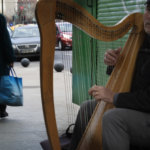
Federica Di Benedetto
Nasco a Roma nel 1987 e inizio a fotografare nel 2007, durante un viaggio che compio da sola a Venezia con una Kodak usa e getta.
Dal 2014 al 2016, dopo avere lasciato gli studi di medicina, studio fotografia presso il CSF Adams e da allora inizio a lavorare nel mondo del teatro come fotografa di scena (da due anni sono la fotografa ufficiale del Teatro Eliseo).
Ho al mio attivo i seguenti progetti personali: “Con Voi” (reportage fotografico su il Teatro Patologico), “Riflessioni” (progetto multidisciplinare di fotografia e poesia), “Ritratti senza volto”, “La mia casa mangia luce” e “Noce”.
Studio teatro dall’età di tre anni e nel 2016 ho conseguito il diploma in Arte Drammatica presso Teatro Azione.
I was born in Rome in 1987 and I started to take photos from 2007, during a trip I made alone in Venice with a disposable Kodak.
From 2014 to 2016, after having interrupted the study of Medicine, I studied photography at CSF Adams and since then I started to work as a stage photographer (I have been the official photographer of Teatro Eliseo for two years).
Up to now I did these projects: “With You” (a reportage about Teatro Patologico), “Riflections” (a multidisciplinary project of photography and poetry), “Portraits whithout face”, “My house eats the light” and “Nut”.
I’ve been studying dramatic art since I was three years old and in 2016 I graduated in Teatro Azione.
CE L’HAI TU UN LAMPIONAIO?
“A cosa potranno servire, spersi nel cielo, su di un pianeta senza case e senza abitanti un lampione e un lampionaio? Forse quest’uomo è veramente assurdo, però è meno assurdo del re, dell’uomo d’affari e dell’ubriacone. Almeno il suo lavoro ha un senso, quando accende il suo lampione, è come se facesse nascere una stella in più o un fiore. Quando lo spegne addormenta il fiore o la stella. È una bellissima occupazione ed è molto utile, perché è bella.”
Questa era la battuta che preferivo dire ogni volta che recitavo il Piccolo Principe. Il quinto pianeta era decisamente il mio favorito.
Da allora, ogni lampione che incontro, suscita la mia attenzione. Mi domando: “che storia hai? Quanti anni hai? Ce l’hai tu un lampionaio?”
I “quinti pianeti” che ho fotografato si trovano rispettivamente a Venezia, Trieste e Muggia, si affacciano sul mare e ogni tanto ricevono la visita di un Piccolo Principe e un lampionaio.
DO YOU HAVE A LAMPLIGHTER?
“What are a street lamp and a lamplighter for, somewhere in the heavens, on a planet which has no people, and no houses? It may well be that this man is absurd. But he is not so absurd as the king, the businessman, and the tippler. For at least his work has some meaning. When he lights his street lamp, it is as if he brought one more star to life, or one flower. When he puts out his lamp, he sends the flower, or the star, to sleep. That is a beautiful occupation. And since it is beautiful, it is truly useful.”
These were the lines I loved to say everytime I played The Little Prince. The fifth planet was certainly my favourite one.
Since then, every street lamp that I meet raises my attention. I wonder “Which is your history? How old are you? Do you have a lamplighter?”
The “fifth planets” that I shooted are in Venezia, Trieste and Muggia, in front of the sea and sometimes are visited by a Little Prince and a lamplighter.



Gabriele Di Stefano
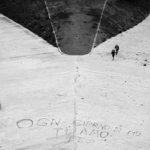
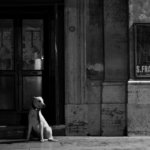
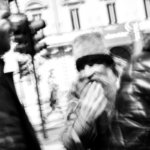
Andrea Frullini
Ho iniziato a fotografare quando ero un ragazzino, con una vecchia macchinetta compatta.
Negli anni novanta ho “scoperto” la fotografia con la gloriosa Pentax K100.
Per qualche ragione all’inizio degli anni 2000 ho smesso di scattare, ma non ho mai smesso di amare la fotografia.
Qualche anno fa mia moglie mi ha regalato un libro per il mio compleanno, era un GROSSO libro sui fotografi della Magnum… WOW!
Ho avvertito l’urgenza di ricominciare a fotografare. Sono entrato nel “mondo digitale”, e mi è piaciuto!
Ho studiato con insegnanti come Lucia Perotta, Daniele Zedda, Salvatore Sanna, e ho scattato, e scattato.
Oggi mi sono dedicato a progetti di paesaggio, anche urbano, di street, e di ritratto, e on voglio più smettere!
Le mie foto sono state esposte in varie gallerie in Europa e nel mondo: ad Atene, Barcellona, Belgrado, Edinburgo, Brooklyn, Amsterdam, Singapore, Berlino, Milano, fra le altre.
I started to take pictures when I was a child, using an old compact camera.
In the nineties I “discovered” photography with the glorious Pentax K1000.
Fore some reason in early 2000, I did not continue to shoot, but I never stopped loving photography.
Some years ago my wife gave me a book for my birthday, it was a BIG book about the Magnum photographers… WOW!
I felt the urge to take photos. I entered in the “digital world”, and I loved it!
I have studied with teachers like Lucia Perrotta, Daniele Zedda, Salvatore Sanna, and I have shot more and more.
Today I’m devoting myself to landscape, urban, street and portrait projects.
And I don’t want to stop!
My photos have been exhibited in various galleries in Europe and around the world: in Athens, Barcelona, Belgrade, Edinburgh, Brooklyn, Amsterdam, Singapore, Berlin, Milan, and many others.
Ed improvviso, la nebbia
Bordeaux, Place de la Bourse, la piazza-specchio. Durante l’estate la piazza si riempie di persone, turisti, bambini, che giocano e corrono sulla sua superficie, costantemente bagnata in modo da riflettere lo splendido scenario della piazza. D’improvviso, la nebbia. Tutto viene avvolto nell’ovatta, e quelle persone, che prima erano colori nel sole, diventano ombre, ombre che giocano, che corrono, che piangono, che danzano… in quella nebbia artificiale che le allontana, che le isola, almeno per un po’, dal mondo reale.
And suddenly, the fog
Bordeaux, Place de la Bourse, the square-mirror. During the summer the square is filled with people, tourists, children, who play and run on its surface, constantly wet to reflect the beautiful scenery of the square. Suddenly, the fog. Everything is wrapped in cotton wool, and those people, who were previously colours in the sun, become shadows, shadows that play, that run, that cry, that dance… in that artificial fog that moves them away, that isolates them, at least for a while, from the real world.
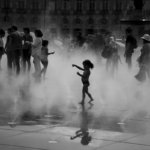
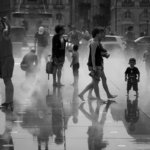
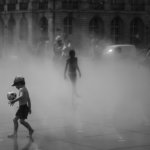
Giusi Bonomo
sono nata a Modica, città in cui vivo e lavoro.
Dopo gli studi di giurisprudenza e il lavoro in ambito legale, mi dedico alla fotografia e al teatro, partecipando a vari corsi, seminari e laboratori concettuali di fotografia e teatro. Nel 2015, come membro di un collettivo di fotografia e arte contemporanea, collaboro alla realizzazione del video “Si bruciano il polpaccio” presentato presso la John Cabot University di Roma, partecipando alla mostra fotografica presso il Fiorentini Art Studio di Roma. Il video, verrà selezionato nel giugno 2015, per il Trame. 5, Festival dei libri sulle mafie, diretto dal giornalista e scrittore Gaetano Savatteri.
Nel 2015 collaboro alla redazione di articoli per la rivista on line “La Pagina”, mentre nei primi mesi del 2017, partecipo alla realizzazione di “Fotografica-mente”, percorso di foto counselling presso il Consultorio di Ragusa. Nel mese di Aprile 2017, vengo invitata alla mostra collettiva di arte contemporanea “Sensorium” in collaborazione con il MACT & CACT Arte Contemporanea Ticino, presso la Galleria civica di Floridia (SR).
Nel mese di Agosto 2017, partecipo con due lavori, al contest fotografico “1801 Passaggi” un paese italiano 2017, a cura del MAVI Museo Antropologico Visivo Irpino e dell’associazione LaPilart, finalizzato alla creazione di un archivio. Entrambi i miei lavori, vengono acquisiti ed entrano a far parte dell’archivio del museo. Una opera fotografica è seconda classificata.
Nel mese di ottobre 2017, vengo invitata alla mostra collettiva di fotografia VIRIDI presso il Museo del Fiore di Sanremo, mentre nel novembre 2017, partecipo con un’opera fotografica alla mostra collettiva di fotografia Letterature urbane 2.0 presso Arca San Marco di Vercelli.
Nel 2018, due miei lavori fotografici dal titolo “Insoliti urbani” e Spazio, apertura, libertà, vengono selezionati e pubblicati su Clic.hè, web magazine di fotografia e realtà visuale.
Un lavoro fotografico dal titolo “Persona” sull’ Identità nel contemporaneo, sarà esposto nell’ambito del Sifest off 2018, festival di fotografia che avrà luogo a settembre 2018 a Savignano sul Rubicone.
Attualmente collaboro alla redazione di articoli su teatro, mostre e altri eventi per il blog Modulazioni temporali.
I was born in Modica, the city where I live and work.
After studying law and working in the legal field, I devoted myself to photography and theater, participating in various courses, seminars and conceptual workshops of photography and theater. In 2015, as a member of a collective of photography and contemporary art, I work on the video “Si bruciano il polpaccio” presented at the John Cabot University in Rome, participating in the photographic exhibition at the Florentine Art Studio in Rome. The video will be selected in June 2015 for the Trame. 5, Festival of books on the mafias, directed by the journalist and writer Gaetano Savatteri.
In 2015 I am contributing to the writing of articles for the online magazine “The Page”, while in the first months of 2017, I participate in the realization of “Photographic-mind”, photo counseling path at the Consultorio di Ragusa. In April 2017, I was invited to the group exhibition of contemporary art “Sensorium” in collaboration with MACT & CACT Arte Contemporanea Ticino, at the Civic Gallery of Floridia (SR).
In the month of August 2017, I participate with two works, in the photographic contest “1801 Passages” an Italian country 2017, organized by the MAVI Museo Antropologico Visivo Irpino and the LaPilart association, aimed at creating an archive. Both my works are acquired and become part of the museum archive. A photographic work is classified second.
In October 2017, I will be invited to the group exhibition of photography VIRIDI (edited by Laura Manione) at the Sanremo Flower Museum, while in November 2017, I will participate with a photographic work at the collective exhibition of photography 2.0 Urban literature at Arca San Marco di Vercelli.
In 2018, two of my photographic works entitled “Urban Unusual” and Space, Openness, Freedom, were selected and published on Clic.hè, a web magazine of photography and visual reality.
A photographic work entitled “Persona” on ‘Identità nel contemporaneo’ will be exhibited in the Sifest off 2018, a photography festival that will take place in September 2018 in Savignano sul Rubicone.
Currently I am contributing to the editing of articles on theater, exhibitions and other events for the blog Time Modulations.
Se i muri potessero parlare…
Se i muri potessero parlare chissà cosa direbbero, testimoni inconsapevoli di passi o attraversamenti, luoghi di incroci di sguardi, di urla di bambini festosi, di palloni buttati; superfici di facili appoggi, di manifesti funebri, di demoni meridiani e ginocchia sbucciate, di ombre al calar della sera.
Se i muri potessero parlare, avrebbero di sicuro una storia personale, adatta per ognuno, un aneddoto da raccontare, la muffa che spinge, l’intonaco che cede.
L’effetto materico delle emozioni, il fascino del tramonto umano.
Se i muri potessero parlare..come mappe racconterebbero di noi, di quella volta con gli occhi chiusi affrettando il conto contro il muro e il fiato corto, il sudore, gli occhi spalancati nelle corse affannate, alla ricerca di chi si era nascosto..
Ogni muro evoca il passare del tempo, con i suoi segni e le sue crepe dà la misura dell’accadimento, della fragilità dell’esistenza.
If the walls could talk …
If the walls could speak who knows what they would say, unaware witnesses of steps or crossings, places of intersections of glances, of screams of festive children, of thrown balls; surfaces of easy supports, of funeral posters, of meridian demons and peeled knees, of shadows at nightfall.
If the walls could speak, they would certainly have a personal story, suitable for everyone, an anecdote to tell, the mold that pushes, the plaster that yields.
The material effect of emotions, the charm of human sunset.
If the walls could talk … as maps would tell of us, of that time with eyes closed hastening the bill against the wall and shortness of breath, the sweat, eyes wide open in the rushed races, looking for those who had hidden ..
Each wall evokes the passing of time, with its signs and cracks giving the measure of the event, of the fragility of existence.
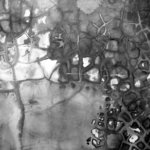
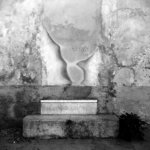
Luigi Stranieri
The Flat City
Nel 2017 Nagoya è stata nominata città più noiosa del Giappone.
In un sondaggio istituito dalla corrispondente ISTAT giapponese si è scoperto che Nagoya è la città meno visitata e quella in cui i giapponesi non vorrebbero andare. Le ragioni sono per lo più legate al fatto che Nagoya è conosciuta come città industriale e commerciale, senza delle vere e proprie attrazioni turistiche come per esempio hanno Tokyo oppure Osaka. Senza riferimenti storici come invece hanno Kyoto e Nara, ma sembra che soprattutto gli abitanti di Nagoya non siano visti come affabili e ospitali.
Questa cosa mi ha incuriosito molto, io ci vivo da tanti anni e non ho mai trovato questa città particolarmente divertente in effetti ma nemmeno così diversa da altre come Yokohama oppure Shizuoka.
Sono partito con questo progetto nel 2016 e sono ancora alla ricerca della noia che invade la città.
Nagoya – Dicembre 2018
The Flat City
In 2017 Nagoya was named the most boring city in Japan.
In a poll set up by the Japanese ISTAT correspondent it was discovered that Nagoya is the least visited city and one in which the Japanese would not want to go. The reasons are mostly related to the fact that Nagoya is known as an industrial and commercial city, without real tourist attractions such as Tokyo or Osaka. Without historical references as have Kyoto and Nara, but it seems that especially the inhabitants of Nagoya are not seen as friendly and hospitable.
This thing has intrigued me a lot, I’ve been living there for many years and I’ve never found this city particularly fun indeed but not so different from others like Yokohama or Shizuoka.
I started with this project in 2016 and I am still looking for the boredom that invades the city.
Nagoya – December 2018
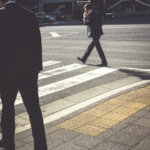
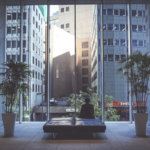
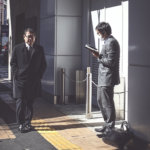
Maritza Bianchini
Fotografa e psicologa romana. Il mio lavoro artistico si inscrive all’interno di quella che viene definita Fotografia Urbana. Gli scatti di cui si compone la mia fotografia sono dei piccoli ritratti urbani che raccontano la città, il territorio, i luoghi di appartenenza e la loro storia con uno sguardo spesso rivolto agli aspetti meno convenzionali e conosciuti che li caratterizzano. Percorsi visivi che raccontano quindi territori, storie, strade, persone, paesaggi urbani e le loro evoluzioni e trasformazioni nel tempo.
Vincitrice del progetto “Città di Fondazione 2.0 – Reinterpretazione artistica di 80 anni di storia” 2018, Mostra d’arte itinerante- realizzato con il contributo della Regione Lazio.
Vincitrice del bando “Sillumina – Copia privata per i giovani, per la cultura – ed. 2017 nella sezione Periferie Urbane, settore Arti visive, performative e multimediali” emanato da SIAE e MiBAC, Km1_Città Visuale Festival.
All’attivo due progetti fotografici in particolare: Segni Urbani, dedicato alle periferie/borgate ufficiali romane e Luoghi Dismessi Project, relativo al racconto fotografico e documentaristico dei luoghi dismessi e abbandonati delle nostre città, inoltre mi sono dedicata all’autoproduzione di Fanzine, veicolando tali contenuti tramite la realizzazione di mostre ed eventi dedicati all’interno di svariate manifestazioni culturali/artistiche e pubblicazioni.
Curatrice e autrice degli scatti presenti nel libro “Passeggiando nella periferia romana” , edito da Iacobelli Editore, settembre 2018.
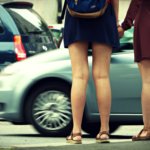
Andrea Minestrini
La sensazione che provo quando scatto la mia fotografia è simile all’approccio di un nuovo amore, la gioia del dare e l’emozione dell’essere corrisposto. Tutto si traduce in attimi.
The feeling I feel when I shoot my photography is similar to the approach of a new love, the joy of giving and the emotion of being reciprocated. Everything translates into moments.
Andrea Minestrini fotografa con passione dal 2013 frequentando i corsi di fotografia di portfolio, di ritratto e di viaggio presso Lilith di Silvia Bigi a Ravenna.
Trova nella fotografia di strada il suo progetto di vita.
Scatta preferibilmente in bianco e nero alla ricerca della semplicità, nella gestualità figurativa del quotidiano, nel ricordo, nel contatto umano, contornata talvolta da un apostrofo d’ironia.
Andrea Minestrini has been photographing with passion since 2013 attending portraiture, portrait and travel photography courses at Silvia Bigi’s Lilith in Ravenna.
Find his life project in street photography.
It shoots preferably in black and white in search of simplicity, in the figurative gestures of everyday life, in memory, in human contact, sometimes surrounded by an apostrophe of irony.
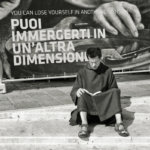
Nina Smidek
Sono nata a Praga, in una casa che è per me quello che è stato il castello di Ma mère per Marcel Pagnol.
Quella casa trattiene l’odore di un’infanzia felice, protetta dall’amore degli antenati e dove sembra che il tempo si sia fermato. Costruita negli anni venti, per accogliere i cechi viennesi che ritornano in Boemia dall’ex capitale del Impero austro-ungarico alla fine della seconda guerra mondiale. Questa casa era l’impostazione di tre epoche che stavano per segnare la storia del mio paese e della mia famiglia. Ha ospitato quattro generazioni di pittori, donne e uomini.
Sono cresciuta circondata da dipinti. Da bambina, ero solita parlare con gli estranei intimi rappresentati nel ritratti. Osservai le ombre mobili sui muri, dagli alberi che ondeggiavano nella brezza esterna, ascoltavo il cigolio notturno delle scale di legno. Un mondo immaginario e misterioso mi abitava. Ma quel mondo di ieri è stato spazzato via dalla seconda guerra mondiale, e in seguito dai lunghi anni di regime totalitario.
Tuttavia ho sempre saputo che si sarebbe risvegliato di nuovo in me. Come se fosse mio dovere riaccendere quella via della creazione, dietro l’assoluta necessità di sopravvivere e affrontare le preoccupazioni quotidiane. Dopo venti anni a Parigi dedicati alla musica classica, e stretta intimità con la pittura, nutrita dalle eccezionali mostre che si svolgono nella città delle luci, sono poi tornatoa a Praga alla ricerca delle mie radici. Lì ho trovato mia nonna all’ultimo barlume della sua vita. Pur desiderando di rendere eterna la sua immagine, ho trovato la mia strada. Con i primi ritratti, era come se alla fine tutto fosse perfetto. Anche se non posso recuperare il tempo e diventare io stesso una pittrice , conferisco una forma alle visioni che vivono in me, attraverso le mie fotocamere. Ora, di nuovo a Parigi, i ricordi della mia Praga, la mia musica e i suoi silenzi accompagneranno sempre il percorso degli occhi che ho scelto alla fine e vivrò vividamente all’interno dei miei dipinti, trasformando tutte le esperienze di vita in cibo per l’anima, alimentando ogni volta un po ‘di più la mia visione dell’esistenza.
I was born in Prague, in a house that is for me what was le Château de ma mère for Marcel Pagnol.
That house detains the smell of a happy childhood, protected by the forebears’s love and where the time seems to have stopped.
Built in the twenties, in order to welcome Viennese Czechs coming back to Bohemia from the former capital of the Austro-Hungarian Empire at the end of World War II. This house was the setting of three eras which were about to mark the history of my country and of my family.
It sheltered four generations of painters, women and men. Hence, I grew up surrounded by paintings. As a child, I used to talk to the intimate strangers represented in the portraits. I gazed at the moving shadows on the walls, from the trees swinging in the breeze outside, I would listen to the nocturnal creaking of the wooden stairs. An imaginary and mysterious world was inhabited me.
But that world of yesterday was blown out by the Second World War, and later by the long years of totalitarian regime. Nevertheless I always knew it would awake again in me. As if it was my duty to rekindle that path of creation, left behind by the utter necessity of surviving and coping with everyday worries.
After twenty years in Paris dedicated to classical music, along with entertaining a close intimacy with painting, nourished by the exceptional exhibitions that are taking place in the City of Lights, I then returned to Prague in quest of my roots.
There I found my grand-mother at the last glimmer of her life. While willing to eternalize her image, I found my path. With the first portraits, it was as if everything was fitting at last. Though I can’t make up for time and become a painter myself, I give a form to the visions living in me, through my camera. Now, back again in Paris, my prague’s remembrances, my music and it’s silences will always accompany the path of eyes that I have chosen at last and will be vividly living inside of my paintings, turning all life experiences into food for the soul, thriving each time a little more my vision the existence.
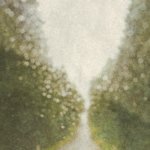
Stelvio Peti
stelviopp@libero.it
Tutto è cominciato tanti anni fa, mio padre quando ero ragazzo mi regalò una “scatola” di plastica ad obiettivo fisso … era la mia prima 6×6 !!! Poi la passione è cresciuta ed ho cominciato a fotografare di tutto … la voglia era troppo pressante non sapevo cosa scegliere … Quando sono diventato “grande” … ma poi sarà vero (?) … ho affinato la tecnica (provare, provare, provare) e sono diventato un fotografo sportivo. Mi piace troppo fotografare l’imprevedibile come il sollevamento pesi … a colori … in B/N … in mosso. Riprendo quasi esclusivamente donne. Ho frequentato dei corsi di fotografia per imparare sempre di più e sono un attento osservatore in cerca di immagini. Ora non mi separo mai dalla mia Nikon ….
All started many years ago, my father when I was a boy he gave me a plastic “box” with a fixed lens … it was my first 6×6 !!! Then the passion grew and I started to take pictures of everything … the desire was too pressing I did not know what to choose … When I became “big” … but then it will be true (?) … I have refined the technique (try, try, try) and I became a sports photographer. I like too photographing the unpredictable as weight lifting … in color … in B / W … in motion. I take almost exclusively women. I attended photography courses to learn more and I’m a careful observer looking for images. Now I never separate from my Nikon ….
La strada – Ambiente di vita
La strada, luogo di incontri, di passaggi, di visioni, di drammi, di gioie ovvero luogo di vita. La strada è il luogo dove ognuno vive il proprio scampolo di vita condividendolo con altri oppure semplicemente da solo. La strada non mente mai, la strada è la verità.
Street – Living environment
The street, a place of encounters, of carries, visions, of drama, of joys, street is living place. Street the place where everyone lives their remnant of life by sharing with others or simply on its own. Street never lies , the street is the truth.
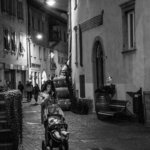
Simonetta Milazzo
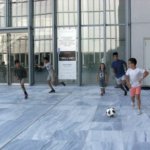
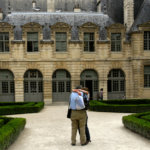
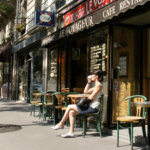
Tomasz Mlynarczyk
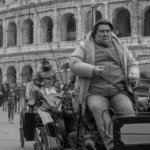
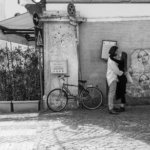
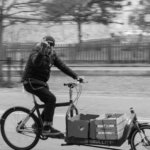
Giuliano Vaccai
Click here to see the full project
Sono nato ad Assisi il 09/02/1996 in provincia di (PG). Ho frequentato il Liceo Artistico Bernardino di Betto a di Perugia. Nei miei studio mi sono dedicato alla pittura, all’architettura ed ora sono al mio ultimo anno all’Accademia di Belle Arti di Venezia e frequento l’indirizzo di Nuove Tecnologie per l’Arte. Prevalentemte lavoro con la fotografia e il video.
I was born in Assisi (Perugia) on 9th February 1996. I attended Liceo Artistico Bernardino di Betto in Perugia. I studied painting, architecture and I am now in my last year of visual arts and technology studies at The Academy of Fine Arts of Venice. I deal with photography an video-making.
Piazzale Roma (VE)
Il progetto su Piazzale Roma, nasce nel 2017. Inizialmente l’idea di voler fotografare questo unico punto di arrivo, nella città lagunare di Venezia, era mosso dall’esigenza personale di fare pratica fotografica. La composizione era ciò che mi interessava ed un luogo/terminal come Piazzale Roma, dove c’è un continuo movimento di persone tra turisti, lavoratori e mezzi, mi offriva la possibilità di sperimentare. Mi sono appassionato al progetto e per quasi un anno, da Settembre 2017 a Luglio 2018, sono andato quotidianamente sul posto e ho imparato a conoscere la zona.
Le tre immagini che ho scelto sotto attimi fugaci nelle quali, oltre alla presenza umana, ritraggo tre monumenti simbolo di Piazzale Roma: Garage San Marco (001) – Hotel Santa Chiara (002) – Il ponte della Costituzione (003). Ciò che accomuna le tre foto, oltre ad averle scattate nella stessa area è il fatto che in esse sono rappresentati tre lavoratori nel mentre della loro attività: nella prima foto ritraggo la donna addetta ai bagni di GarageSan Marco, mentre conta i soldi dopo essere stata pagata da una turista per accedere al servizio. Nella seconda il soggetto è l’addetto alla resempcion dell’Hotel Santa Chiara, che si intravede dalla finestra preso di spalle. La terza foto cattura presumibilmente un lavoratore d’ufficio, sotto il Ponte di Calatrava, che agitato e sofferente risponde ad una chiamata di lavoro.
The project of Piazzale Roma, the only landing place of the Venetian lagoon, began in 2017 as a mere way to practice my photographic skills. I aimed to obtain a particular composition and that place/terminal gave me the chance to experiment, given that countless tourists, workers and means of transport constantly pass through there. I worked on the project for nearly a year, from September 2017 to July 2018. Every day I went to Piazzale Roma in order to get familiar with the area.
I selected three pictures, three fleeting moments that show the human presence around three monuments and symbols of Piazzale Roma: Garage San Marco (001) – Hotel Santa Chiara (002) – The Constitution Bridge (003). With the exception of being shot in the same area, the three pictures have in common the representation of three workers in the middle of their business. The first one shows the attendant of Garage San Marco public toilets counting the money paid by a tourist to gain access to convenience. In the second picture you can glimpse the Hotel Santa Chiara’s receptionist through a window, taken from behind. The third picture captures a possible nervous and stressed employee, under The Constitution Bridge, answering a business call.
